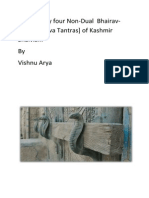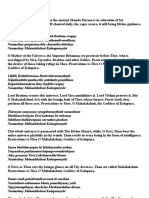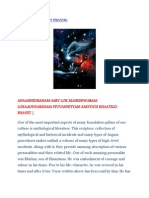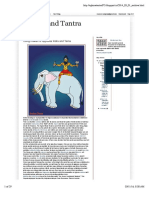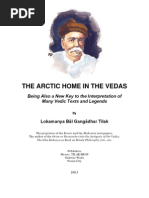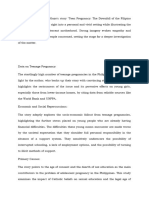Gupta Sadhan Tantra
Gupta Sadhan Tantra
Uploaded by
Rajesh TantiCopyright:
Available Formats
Gupta Sadhan Tantra
Gupta Sadhan Tantra
Uploaded by
Rajesh TantiCopyright
Available Formats
Share this document
Did you find this document useful?
Is this content inappropriate?
Copyright:
Available Formats
Gupta Sadhan Tantra
Gupta Sadhan Tantra
Uploaded by
Rajesh TantiCopyright:
Available Formats
Guptasadhana Tantra
A mantra is, like everything else, Shakti. But the mere utterance of a mantra without more is a mere movement of the lips. Shakti and Shakti, Sir John Woodroffe This tantra is likely quite old. It is quoted as a source in the Matrikabhedatantra, which may possibly date from the 13th century c.e. The edition used for this abstract is No. 311 in the Chowkhamba Haridas Sanskrit series. The work is unabashedly of a Kaula slant, briefly exposed in twelve short patalas (chapters).
Chapter One
Set on the pleasant peak of Kailash mountain, Devi first says that she has heard of the greatness of the path of the Kulas, but now wants to hear more. Shiva says that as he is her slave, and out of love, he will tell her what she requests. Kulachara, he says, is great knowledge and should be concealed, particularly from those of the pashu (herdlike) disposition, in the same way that Devi would hide her sexual organs from others. Kulachara, he says, is the essence of the vedas, the puranas and other shastras, and is very difficult to obtain. Even if he had tens upon tens of millions of mouths, he would be unable to describe the magnificence of the path of Kula. Shakti, he says, is the root of the entire universe, pervading all, and she is the cause of knowledge arising in a sadhaka. Knowing Shakti brings happiness in this world and causes a sadhaka to dissolve in the body of Shakti in the next. Next, Shiva says that the Kulashakti should be worshipped with the five makaras, and describes suitable shaktis for this worship as a dancer, a Kapalini, a whore, a washing girl, a girl who cuts hair, a Brahmani, a Shudrani, a Bhopala maiden and a flower-girl. These are the nine tantrik Kulashaktis.
Chapter Two
Parvati says she wants to know about sadhana, and breaks into a eulogy of the guru. She says the guru is Brahma, Vishnu and Rudra and is the refuge. Guru is sacred bathing places (tirtha), guru is tapas, guru is fire, guru is the sun and consists of the whole universe. She asks by which mantra and in which ways the guru should be served and worshipped. She asks what his meditation image is. Shiva says that women, because of their emotional nature, should not have secrets revealed to them. Nevertheless, out of love for her, he will tell her of the meditation image and the nature of the guru. It should not be revealed to pashus, he warns. He says that just as Kula represents Shakti, so Akula represents Shiva. A person who is dissolved in Shakti is called a Kulina. This is a reference to the idea that Shiva is the witness, inert, a corpse, and it is Shakti, Kula, who creates, maintains and destroys the universe. The guru is the Kula circle, and one should bow to the guru seated in the centre of a great lotus which has the colour of an autumnal moon. He has a face like the full moon, and wears celestial clothes, and is scented with heavenly perfumes. He is united with the greatly alluring Suradevi, on his left, and his hands show the mudras giving boons and dispelling fear. He is marked with every auspicious sign, and is situated in the great 1,000 petal lotus on the head. Shri Parvati then asks to hear more. She wants to know about the meditation image of the guru's shakti. Shiva replies that she is like the red lotus, wearing beautiful red clothes, she has a slender waist, and is adorned with red jewels and a red diadem. She resembles the brightness of the autumn moon, wears beautiful shining earrings, and sits on the left of her own lord (natha). She shows the signs giving boons and dispelling fear and holds a lotus in one of her hands.
Chapter Three
Parvati asks Ishvara, whom she addresses as the giver of liberation, the lord of breath and Mahadeva, about preparatory acts (purashcharana) sadhakas must undertake. As in the Kankalamalinitantra, Shiva says that the way to accomplish sadhana of the great mantra is through one's own will, here described as sveshtachara rather than svecchacharya. The usual defects and rules applying to whether worship is during
the day or night do not apply. At morning, and at midday the sadhaka should recite the mantra and having performed puja should once more recite the mantra at the evening twilight. In the evening, the sadhaka is to offer food and other offerings according to his will. After doing so, the best of sadhakas should also recite the mantra at the dead of night. Together with his own shakti, he should recite the mantra. Joined with his shakti, the mantra gives siddhi, and not otherwise, Shiva says. There is no siddhi without a Kulashakti, even in thousands of millions of years. After worshipping the Kumari, a sadhaka should give her offerings of food and the like and recite the mantra 108 times. After doing so, one should give dakshina (gift) to the guru, such as gold and clothes. Unless the guru is satisfied, success in the mantra cannot be obtained. Success means that one becomes like Bhairava or Shiva himself.
Chapter Four
This chapter deals with the shakti and her characteristics. Shankara says that she may be one's own shakti or another's. She should be youthful and intelligent, and should be free of shame (lajja) and disgust (ghrna). After using the five elements according to the rule, the sadhaka should recite the mantraplacing it 100 times on the head, 100 times on the forehead, 100 times where the hair is parted in the centre (sinduramandala or simanta), 100 times on the mouth, 100 times on the throat, 100 times in the region of the heart, 100 times for each of her breasts, 100 times for the navel, and 100 times at the yoni. After doing so, the sadhaka should think of himself as one with Shiva, and using the Shiva mantra should worship his own lingam. Chewing tambula (pan), and with bliss or excitement in his heart, he should place his lingam in the yoni of shakti. He should offer his atma, together with dharma and adharma, and everything else in his nature as a sacrificer offers to fire in the susumna nadi using a mantra ending with Svaha. Then, while still joined with his shakti, he should utter the mantra 100 or 1,000 times. The full sacrifice, which here implies orgasm, he should then offer using the prakashakasha mantra, again ending with Svaha. The semen which flows from this orgasm should then be offered to the Devi. It may be noted here that this whole process, though couched in explicitly sexual terms, can also refer to the bliss when Kundalini rises through the sushumna nadi and the chakras. Whoever worships according to the previous method, says Shiva, becomes free from illness, wealthy, and equal to the god of love Kama himself. His enemies are all destroyed, and he becomes successful on earth, gaining all dominion, and equal to Shiva himself.
Chapter Five
After all this excitement, Parvati wants to know about preparatory acts, and how many times the mantra given to the disciple by the guru should be recited in the months after initiation. Shiva says that during the first month, the mantra should be recited 600,000 times, in month two 1,200,000 times, and in the third month 1,600,000 times. In months four and five, the number is 3,000,000 times for each. In month six, the mantra has to be recited 3,600,000 times, and in the seventh month, 4,200,000 times. In the eighth month, japa is 4,400,000 times, and in month nine 4,500,000 (or could be 5,400,000) times. Month ten needs recitation 6,000,000 times, while month 11 the number creeps up to 6,500,000 times. By the time the last month of the year is reached, the mantra has to be recited 10,000,000 times. Shiva says that only be reciting the mantra this many times, does it become successful. As well as worshipping the shakti in the manner described in chapter four, a sadhaka must also worship the Kumaris, or virgins, feeding them and so forth. The Kulachudamanitantra goes into some detail about this process. Shiva says here that without shakti, he has the form of a corpse, while when he is joined with the devi, he is Shivo-ham.
Chapter Six
The goddess says she wants to know about the Dakshina form of Kalika, who she describes as the giver of siddhi, and very hard to get knowledge of in the three worlds. Shiva says he will reveal this information, which, he says is also spoken of in the Kalitantra and in Yamala. He says that knowing the essence of Dakshina Kali liberates an individual from the ocean of being and says that Bhairava is the rishi who revealed the mantra, it should be pronounced in the Ushnik metre. He gives the linchpin (kilaka), shakti and other details and says that the application of the mantra is the four ends or aims of all human beings,
dharma, artha, kama and moksha. He tells the Devi that he has already given the complete mantra in the Kalitantra. Devi then responds by asking about different elements in puja including meditation, the place of worship the different asanas (positions, seats) called Alidha and Pratyalidha, the cremation ground, and the nights when she should be worshipped. He answers that a candidate should be an adhikari, that is competent or entitled to worship Kalika, and should do the daily puja dedicated to his or her guru, or the guru's son or the guru's shakti. Without this, the fruit of a sadhaka's puja is taken by the rakshas and the yakshas. The guru and his or her family are to be offered the fruit of the puja and satisfied in every way. The Alidha and Pratyalidha postures are the form of Kali as the destroyer and deluder of the universe, the form of Kali as fire itself, and so situated in the cremation ground. By performing these according to the injunctions of the guru, one obtains the four aims of mankind. One should do the puja, by implication in the cremation ground, at night at a time which appears to be in the second ghatika (a ghatika =24 minutes) after midnight. On a great night of Kali, one should perform puja at midnight, using the five bhavas, here meaning the five makaras, as part of vira sadhana. Worshipping at different times, and in the different velas, gives different results. Those of the divine and heroic dispositions (bhavas), should worship using the five tattvas, at midnight, to achieve the highest results and become free from time.
Chapter Seven
The chapter opens with something of a tiff between Shiva and Shakti. The goddess wants to know about the tattva, and entreats Shiva, if he has love for her, to reveal these details. Shiva replies that she herself is the supreme tattva, while he is a scatterbrain, and got it from her. Devi entreats him to speak, and he says that he has spoken of these matters in many tantras of old. He asks her why she keeps asking again and again. After another short exchange, Shiva launches into the matter in hand. He reveals a five syllabled purifying mantra which he says is hidden in all the tantras and which refers to the five elements of the hidden ritual. He then describes how this affects the different worshippers. Brahmins, he says dissolve into the supreme tattva, just as water flows into water; Kshatriyas achieve oneness (sahayoga); Vaishyas gain equality with the Devi, Shudras dwell eternally in the Devi's heaven; while others achieve equality with the (supreme) tattva. More details, he says, may be found in the Nilatantra, which may be the Brihadnilatantra, and in other places such as yamalas.
Chapter Eight
This chapter describes a chakra which may be used to decide whether a given Mantra will produce success. The then follows a description of the bases used for puja. These may be yantras, gems, images, or a Shiva lingam. Unlike some other tantras, this work recommends the puja using the lingam should be performed only when the lingam is made of a permanent substance. The Todala Tantra recommends that Shiva lingams should be made of clay. This chapter only has 22 verses.
Chapter Nine
This entire chapter is devoted to the worship of Dhanada Lakshmi. It includes her Mantra, Yantra, puja, Kavacha, and other ritual details. Dhanada bestows wealth to a devotee.
Chapter Ten
Deals with the worship of the Goddess known as Matangi. contains the hymn of Matangi, Kavacha and the Mantra. She bestows the four aims of mankind.
Chapter Eleven
This brief chapter covers the garland of letters, of 50 letters of the alphabet which make up the body of the goddess. It also deals with the physical rosary and describes the different substances from which it may be
fashioned. These include crystal, red sandalwood, and beads of the Rudraksha plant. The best rosary is made of human skulls, and as also described as the great conch rosary. Inner recitation of the mantra is more powerful than external japa.
Chapter Twelve
The Mantra known as Gayatri is described in this chapter. The fifteen verses describe the Gayatri as the greatest of all mantras. having this tantra in one's house protects from all misfortunes, and brings liberation.
You might also like
- Cards - Against - Muggles - Full - EditionDocument152 pagesCards - Against - Muggles - Full - EditionElizabeth WhiteNo ratings yet
- SavedDocument2 pagesSavedGeaninaLuciana100% (1)
- Niruttara TantraDocument5 pagesNiruttara TantraashishpuriNo ratings yet
- Tripura Sundari The Goddess of Beauty, Love and Enjoyment PDFDocument4 pagesTripura Sundari The Goddess of Beauty, Love and Enjoyment PDFbroxie100% (3)
- List of Sixty Four Non Dual Bhairav Agams Saiva Tantras of Kashmir Shaivism LibreDocument10 pagesList of Sixty Four Non Dual Bhairav Agams Saiva Tantras of Kashmir Shaivism LibrechetanKhandupatilNo ratings yet
- Tara SadhnaDocument1 pageTara SadhnaNikhil ShreeNo ratings yet
- The Yogini HridayaDocument4 pagesThe Yogini Hridayaviky24No ratings yet
- MatangiDocument3 pagesMatangivrohit308No ratings yet
- CONQUEST OF THE SERPENT-A Way To Solve The Sex ProblemDocument55 pagesCONQUEST OF THE SERPENT-A Way To Solve The Sex ProblemPrecisionetica100% (1)
- Guptasadhana TantraDocument3 pagesGuptasadhana TantraRiddhesh PatelNo ratings yet
- Tantra of the Srikula Part I The secret of the Dark Goddess NikumbhilaFrom EverandTantra of the Srikula Part I The secret of the Dark Goddess NikumbhilaNo ratings yet
- Shiva Shadakshara Stotra:A Hymn on Shiva's Six Syllable MantraFrom EverandShiva Shadakshara Stotra:A Hymn on Shiva's Six Syllable MantraRating: 3.5 out of 5 stars3.5/5 (3)
- Ardhanarishvara Stotra: A Hymn on Unified Form Of Shiva and Shakti by Shankara BhagavadpaadaFrom EverandArdhanarishvara Stotra: A Hymn on Unified Form Of Shiva and Shakti by Shankara BhagavadpaadaNo ratings yet
- Kalabhairavashtakam : Eight Verses on Kalabhairava By Shankara BhagavadpaadaFrom EverandKalabhairavashtakam : Eight Verses on Kalabhairava By Shankara BhagavadpaadaNo ratings yet
- Adoration of Sri MookambikaDocument6 pagesAdoration of Sri MookambikaK Krishna Rao100% (1)
- Sundari Shyamala and VarahiDocument4 pagesSundari Shyamala and VarahiAnilkumar Shankarbhat Nagarakatti100% (1)
- Kaulachara (Written by Guruji and Posted 11/3/10)Document4 pagesKaulachara (Written by Guruji and Posted 11/3/10)Matt Huish100% (1)
- Das MahavidyaDocument3 pagesDas MahavidyadrdjhaNo ratings yet
- Gandharva TantraDocument23 pagesGandharva TantraNgurah MahasviraNo ratings yet
- Tripur BhairaviDocument4 pagesTripur Bhairavivijayxman100% (2)
- Maha Ganapati HomamDocument40 pagesMaha Ganapati Homamkrishvidhya2000No ratings yet
- Pancha Mukha Anjaneya KavachamDocument10 pagesPancha Mukha Anjaneya KavachamKrishna KumarNo ratings yet
- Gandharva Tantra PDFDocument23 pagesGandharva Tantra PDFNaresh Muttavarapu100% (1)
- Vakrakubjik ADocument3 pagesVakrakubjik ASiva Nayak100% (1)
- Shakti Sadhana: Kamala Is One of The, The Most Important Goddess Forms in - To Read More About Kamala, ClickDocument3 pagesShakti Sadhana: Kamala Is One of The, The Most Important Goddess Forms in - To Read More About Kamala, ClickPankaj D Patel100% (5)
- 64 YoginisDocument5 pages64 YoginisTantra PathNo ratings yet
- 1.6 MatangiDocument8 pages1.6 MatangiallandzxNo ratings yet
- Devi RahasyaDocument4 pagesDevi RahasyaAnandh ShankarNo ratings yet
- Apsara 5Document11 pagesApsara 5ajay khanna0% (1)
- Creating Sacred Space: Bhu-Shuddhi, Bhuta-Shuddhi - Dismissing The Resident SpiritsDocument46 pagesCreating Sacred Space: Bhu-Shuddhi, Bhuta-Shuddhi - Dismissing The Resident SpiritsBruno Dias100% (4)
- Sri Lalitha Sahasranamam OverviewDocument2 pagesSri Lalitha Sahasranamam OverviewAditya HridayamNo ratings yet
- Kamakhya Devi Temple Guwahati PDFDocument7 pagesKamakhya Devi Temple Guwahati PDFindrani royNo ratings yet
- Bala Tripura Sundari Sadhana Book - Google SearchDocument2 pagesBala Tripura Sundari Sadhana Book - Google SearchAnonymous ScdwAput0% (1)
- Yantra and PranapratishtaDocument3 pagesYantra and PranapratishtaVashikaran.OrgNo ratings yet
- Bhairavi - FacebookDocument8 pagesBhairavi - FacebookMislioc TragateljNo ratings yet
- The Yogini Hridaya An Overview PDFDocument5 pagesThe Yogini Hridaya An Overview PDFVivek SinghNo ratings yet
- BhairavDocument6 pagesBhairavmayurranjan100% (3)
- Panchatattva and Tantric InitiationDocument4 pagesPanchatattva and Tantric InitiationBhadraKaaliNo ratings yet
- Sures Chandra Banerji - A Companion To TantraDocument343 pagesSures Chandra Banerji - A Companion To Tantralazar_5067% (3)
- 05chinmasta Mantra SadhanDocument3 pages05chinmasta Mantra SadhanPrabhavathi AyyagariNo ratings yet
- Mantra For Darshan of Lankapati RavanDocument3 pagesMantra For Darshan of Lankapati Ravansiddh tantra mahasadhana marg100% (1)
- A Yakshini Is A Species of Supernatural EntityDocument9 pagesA Yakshini Is A Species of Supernatural EntityKambhampati Sandilya50% (4)
- Yogini TantraDocument3 pagesYogini Tantraprasch0% (1)
- Kaulajnananirnaya TantraDocument2 pagesKaulajnananirnaya TantraSean GriffinNo ratings yet
- Chamunda Mantra 108 Times by Sadhna Sargam With Detailed MeaningDocument2 pagesChamunda Mantra 108 Times by Sadhna Sargam With Detailed MeaningJagadeesh SundaramNo ratings yet
- Sangeeta Yogini Shyama Shyamala Mantra NayikadeviDocument1 pageSangeeta Yogini Shyama Shyamala Mantra NayikadeviPrathyan Gara100% (2)
- Apsara Sadhana: Your Zodiac HoroscopeDocument9 pagesApsara Sadhana: Your Zodiac Horoscopesssbulbul0% (1)
- An Exposition On Malini Viyayauttara TantraDocument48 pagesAn Exposition On Malini Viyayauttara Tantrasanjeev koul100% (1)
- Lakshmi Vaasudev PrayogDocument19 pagesLakshmi Vaasudev Prayogsadhubaba100% (1)
- Aghora and Tantra: March 2014Document29 pagesAghora and Tantra: March 2014Mahesh BadgujarNo ratings yet
- Shiv TantraDocument12 pagesShiv TantrasubhashNo ratings yet
- Lalita TripDocument161 pagesLalita TripNagu RamuNo ratings yet
- Bhairava Dashanama Stotra : Ten Names of Bhairava to Overcome Pain and SufferingFrom EverandBhairava Dashanama Stotra : Ten Names of Bhairava to Overcome Pain and SufferingNo ratings yet
- Gujarati Book - Jyotirling Somnath Ni MurtiDocument100 pagesGujarati Book - Jyotirling Somnath Ni MurtiRajesh TantiNo ratings yet
- AntiHindu Prevention of Communal and Targeted Violence BillDocument8 pagesAntiHindu Prevention of Communal and Targeted Violence BillRajesh TantiNo ratings yet
- Arctic Origin of The AryansDocument470 pagesArctic Origin of The Aryanssudipto917100% (3)
- Rights of Non Muslims in Islamic StateDocument12 pagesRights of Non Muslims in Islamic Stateumer109No ratings yet
- Islam Me Gair MuslimDocument8 pagesIslam Me Gair MuslimRajesh TantiNo ratings yet
- Domestic Violence Lethality Screen For First RespondersDocument1 pageDomestic Violence Lethality Screen For First RespondersAnonymous 4tYiAXmFNo ratings yet
- Chakras EnneagramDocument3 pagesChakras Enneagramfernandeantonio7961100% (5)
- Revision Notes On Section 2.5 - Marriage and PartnershipDocument7 pagesRevision Notes On Section 2.5 - Marriage and Partnershipnisalielisha rodrigoNo ratings yet
- Michel Houellebecq, The Art of Fiction No. 206Document34 pagesMichel Houellebecq, The Art of Fiction No. 206Sergio Fortuño100% (2)
- English Taimanin rpgx-0003 - 2scrip 18+Document17 pagesEnglish Taimanin rpgx-0003 - 2scrip 18+hairez1232No ratings yet
- 21 Jump Street Movie ScriptDocument123 pages21 Jump Street Movie ScriptRicardo DuffeNo ratings yet
- Erotic Body Prayer, by Kirk Prine, Ed.D.Document45 pagesErotic Body Prayer, by Kirk Prine, Ed.D.Roger Pratt67% (3)
- As You Sow So Shall You ReapDocument3 pagesAs You Sow So Shall You ReapPhilip John JonesNo ratings yet
- MalvolioDocument15 pagesMalvolioঅর্ক কোথায়0% (1)
- COMMENTARYDocument4 pagesCOMMENTARYAdrian CadaNo ratings yet
- Dysfunctional Uterine Bleeding History CollectionDocument4 pagesDysfunctional Uterine Bleeding History CollectionAnitha BalakrishnanNo ratings yet
- International, Indexed, Multilingual, Referred, Interdisciplinary, Monthly Research JournalDocument2 pagesInternational, Indexed, Multilingual, Referred, Interdisciplinary, Monthly Research Journaldr_kbsinghNo ratings yet
- Male Chauvinism in AnimeDocument2 pagesMale Chauvinism in AnimeTali Cruz Nuñez0% (1)
- Anne SextonDocument10 pagesAnne SextonStefi Nati100% (1)
- Morris Dees Divorce PapersDocument13 pagesMorris Dees Divorce PapersErik WeberNo ratings yet
- 05 AnneDocument14 pages05 AnnelontrNo ratings yet
- Lawsuit Against Riverside Unified School DistrictDocument59 pagesLawsuit Against Riverside Unified School DistrictThe Press-Enterprise / pressenterprise.comNo ratings yet
- Lesson 4. Gned 10Document15 pagesLesson 4. Gned 10main.maryjane.eugenioNo ratings yet
- Is Banning Porn Websites in India JustifiedDocument3 pagesIs Banning Porn Websites in India JustifiedSHASWAT DROLIANo ratings yet
- SSC Public Examination - 2017 Model Paper - 1Document7 pagesSSC Public Examination - 2017 Model Paper - 1ThirupathaiahNo ratings yet
- Ge Elec 7 - NotesDocument31 pagesGe Elec 7 - NotesEllyza CanonasoNo ratings yet
- UntitledDocument4 pagesUntitledcs_3567No ratings yet
- Sexual Reproduction in PlantsDocument42 pagesSexual Reproduction in PlantsBiobele LongjohnNo ratings yet
- Cinema ParadisoDocument2 pagesCinema ParadisoCamille MartinezNo ratings yet
- Evolution of SexDocument21 pagesEvolution of SexAdam ZHUNo ratings yet
- FOREVER YOURS by Mdutyana NonkoloDocument517 pagesFOREVER YOURS by Mdutyana NonkoloAmanda t mbawa100% (1)
- Amicus BriefDocument20 pagesAmicus BriefMcKenzie StaufferNo ratings yet





